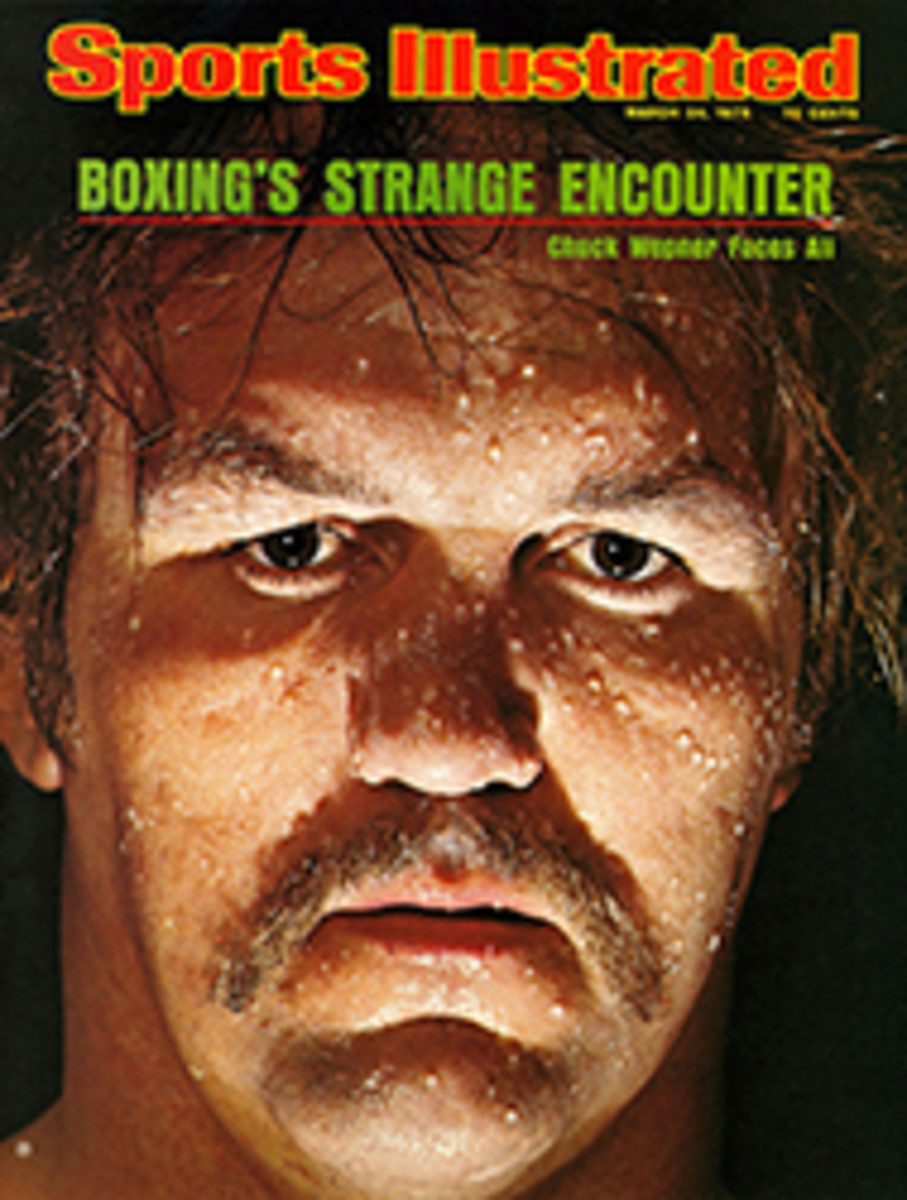
TWO ON A SNOWY SEESAW
Just before the start of the race that would decide once and for all whether Gustavo Thoeni would or would not remain in the running to win an unprecedented fourth World Cup ski championship, the young Italian was asked if he had any special way of preparing himself for such a crucial event. Perhaps he did something mentally to sharpen his concentration, possibly something physical to tune up his legs. Thoeni listened to the question gravely, looking down the slalom run, then replied, "No, I do nothing special. It is just to go very fast. I feel that is most important."
And so it was last week when the World Cup Flying Ski Circus and Wandering Slalom Show stopped by Sun Valley in the Sawtooth Mountains of Idaho to stage four races in three days, the next-to-last event of the season. And if Thoeni did nothing else, it was important that he go very fast indeed, for he was being chased by two of the toughest chargers to come along in many a snowfall. One was the Austrian flash, Franz Klammer, 21, the winner of seven consecutive downhills, a daredevil who has come to be known as The Astronaut by countrymen who see in him the new hero to fill the boots of the likes of Karl Schranz and Toni Sailer. The other racer on Thoeni's ski tails was a freckle-faced kid from, of all places, Sweden—a bastion of Nordic skiers where Alpine racers are about as scarce as surfers. His name is Ingemar Stenmark and he is a bashful 19 years old, an upstart in his second season of World Cup competition. Some upstart. Before Sun Valley he had won four slalom or giant slalom races and posted five second-place finishes. Already, Ingemar is as famous among the home folks as tennis hero Bjorn Borg.
Sun Valley offered two races for the men, a giant slalom and a slalom, and the drama of the clash among Thoeni, Klammer and Stenmark was plainly the theatrical high point of the meet. With the women there was no pressure: Austria's Annemarie Moser-Proell, at 22 the most gifted woman racer in ski history, had already wrapped up her fifth straight World Cup title three weeks ago and appeared in Idaho as a sort of visiting celebrity, like the movie stars of the old days.
There was another welcome ingredient stirred into the scene last week. That was the resurrection of the famous old Harriman Cup that had for nearly 30 years been one of the world's best-known ski trophies. Its history is almost as long and as glamorous as that of Sun Valley itself; it was first awarded in 1937—a year after the resort opened—and it has been won by such notables as Sailer, Gretchen Frazer, Andrea Mead Lawrence and Schranz, who had quaffed champagne from the last cup in 1965. On hand for the occasion was the noble old ambassador himself, Averell Harriman, now 83, returning to the resort he founded in 1936. All through the week Harriman trudged about the race venues in a pair of monumentally baggy ski pants, an ancient parka and battered Alpine hat, declaring to anyone who might ask, "I think skiing attracts the best people." Someone asked Harriman, a lifelong Democrat, if that included President Ford. Harriman thought about it. "Does he ski? Oh, yes, yes. Well, skiing should make him a better President."
The buildup to the heavyweight match started slowly. The first event on the agenda was the women's giant slalom, staged in a leaden morning light on a snaking course called Greyhawk. There was no crowd, the public-address system didn't work and the racers seemed as drab as the day. When the last one hit the finish, the winner turned out to be a promising Swiss newcomer, Lise-Marie Morerod, a scant three-hundredths of a second faster than the veteran Monika Kaserer of Austria. Queen Proell was fifth, but then, why hurry?
Next day the women's slalom picked up the pace under the valley's patented sunny skies, the sort of day that fills the sides of racecourses with folks getting tan and murmuring to one another, "What are these people doing—racing or something?" This time the strong lass from Liechtenstein, Hanni Wenzel, streaked down the course to seize both runs by the stunning margin of almost a full second over Moser-Proell. People just don't beat people by that much in slalom, do they, Hanni? She nodded happily and, when she was told that her victory, plus her sixth-place giant slalom finish, had made her the first woman Harriman Cup winner in a decade, she considered that distinction and asked, "What is the Harriman Cup?"
Then, tensions suitably building on the sidelines, along came the men. Although tight World Cup competition has been old stuff in this series, nothing quite like this three-way contest among Thoeni, Klammer and Stenmark had ever come to pass.
There was champion Thoeni with 219 World Cup points, Klammer with 215 and young Stenmark with 200. And coming from a series of bad-weather races—in deep fogs at Naeba, Japan, swirling Pacific Ocean mists and violent storms at Whistler Mountain near Vancouver and, finally, tons of snow piled upon Jackson Hole, Wyo.—the skiers were in a snappish mood. Nobody was absolutely certain of the mathematical calculations which would determine the 1975 overall winner. Serge Lang, the hulking Swiss sportswriter who conceived the complicated scoring system, carried around a sheet of paper full of heavy pencil scrawls that he pulled from a parka pocket to consult whenever anyone inquired about the scoring situation. What his sheet said, Lang told racers and officials, was that the highest point total Thoeni could attain if he won every one of the remaining four races was 265. And yet, due to the intricacies of Lang's system, Klammer could get 279, though he is not exactly a whiz at slalom and giant slalom, and only one downhill remains, the big finale at Val Gardena next week. Then Stenmark—who never races downhills because, with wisdom beyond his years, he considers them too dangerous—could get, at most, 255 points if he finished first in all the remaining races. What all this meant, Lang announced dramatically, was this: if Stenmark managed to win both races on Greyhawk, he would win the 1975 World Cup championship.
This prospect, even though they didn't entirely understand it, brought out the crowds. In the first giant slalom run, Thoeni started eighth and flashed home in one minute, 23.54 seconds, just behind Italian teammate Piero Gros. At the bottom, everyone nodded wisely: a fine run. Take that, you challengers.
Then the lanky Swede sprang out of the starting gate, his child's face grim, and launched an attack so vicious that a steadily growing shout rolled along with him, following him down the hill. As he zinged through gate after gate, Stenmark seemed to build more speed and, remarkably, seemed to gain more control at the same time. Stenmark races with none of the crash-and-burn, elbows-out enthusiasm of Jean-Claude Killy; he disdains the sit-back style of Patrick Russel, another old French champ. Stenmark skis perfectly, skis flat, swiveling in a building rhythm and powerful economy of motion. And now, Stenmark was taking wing. He hit the finish in a rousing 1:20.80, more than two seconds faster than Gros and a lead—in ski racing—about as long as a lifetime.
The crowd yelled explosively and Ingemar chuckled bashfully. "Oh, it was not so fast," he said. "But then, I did not make any mistakes." His second run was not quite so spectacular, but it was still the best of the round, and when they added up the totals, he had won the giant slalom by the remarkable margin of 2.98 seconds. Gros was second and the champ, Thoeni, third. The point totals now stood: Thoeni 226 Stenmark 225 and Klammer (who had finished a dismal but predictable 21st) still with 215.
Beyond the brilliance of Stenmark's victory, there was a notable bright spot. American Greg Jones had stormed out of the 30th starting spot to seize fourth place. The youthful U.S. skiers are not there yet, but they are definitely improving. There are now no fewer than 15 Americans with World Cup points (meaning they had finished in the top 10 in at least one event) compared with only nine at the end of last season.
Now the stage was set for ski-racing history. Everything rested on the slalom and everything rested on Stenmark as the skiers assembled high on Greyhawk; the course was in superb condition, the day was like bright crystal and the crowd had grown enormously. Stenmark started No. 2 in the first run and posted a promising 54.10. Thoeni seemed strangely sluggish and came home at 54.34. That left Stenmark in third spot, the champion in seventh. Everybody agreed during intermission that one more good run would wrap up a World Cup title for the young Swede. Further, the start order would be reshuffled in such a way that Ingemar would not have to run until after Thoeni and thus would know exactly how many split seconds he needed for victory; he could control his speed and not take the chance of falling all the way to Ketchum. Eight racers went down before Thoeni. The best time was made by Gros: 56.83 seconds.
Then came Thoeni. He burst out of the start and ticked off the gates, snapping flag after flag with a cold and calculating power that was laced through with an awful lot of superman. Last year at the world championship in St. Moritz Thoeni had been eighth after the first run of the slalom and had blasted down the course in a triumphant second run that many consider the finest display of ski-racing strength and skill ever seen. Thoeni's second run at Sun Valley, over a more difficult course, was just as spectacular: 55.54 seconds. No man could match such a run, and the boy from Sweden was certainly not up to it. Ingemar made a noble try and swept in at 56.39 seconds. It was good enough for third place and, adding his times in slalom and giant slalom, it also was good enough for the Harriman Cup.
But what of the World Cup? As the racers headed back halfway around the globe for the final event at Val Gardena in Italy next week, champion Thoeni and challenger Stenmark were deadlocked with 240 points. Klammer was still poised at 215. And here come the possibilities. The first race at Val Gardena is a downhill. Neither Thoeni nor Stenmark will enter it. Klammer will and will be favored to win his eighth straight. The score if that happens? Thoeni 240, Stenmark 240, Klammer 240. And then, the last race of the year will be a dual slalom, sending the racers in short, head-to-head eliminations. Thoeni and Stenmark have the best chances in this event, with Thoeni a slight favorite. But if neither wins, then Klammer could take the World Cup, based on the fact that he has more victories. And then again, he may not.
Whatever happens, two things are certain. One, ski racing has never seen a more sensational windup. And two, no words could sum it up better than Thoeni's own considered philosophy of competition: "It is just to go very fast."
TWO PHOTOS
When Stenmark (below) won the giant slalom, he had the cup by the handle, but then Thoeni (left) took the slalom.
PHOTO
A victory and a sixth gave Hanni Wenzel something she never knew existed, the Harriman Cup.
PHOTO
Harriman, 83, didn't know that Ford skied.

